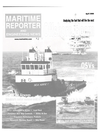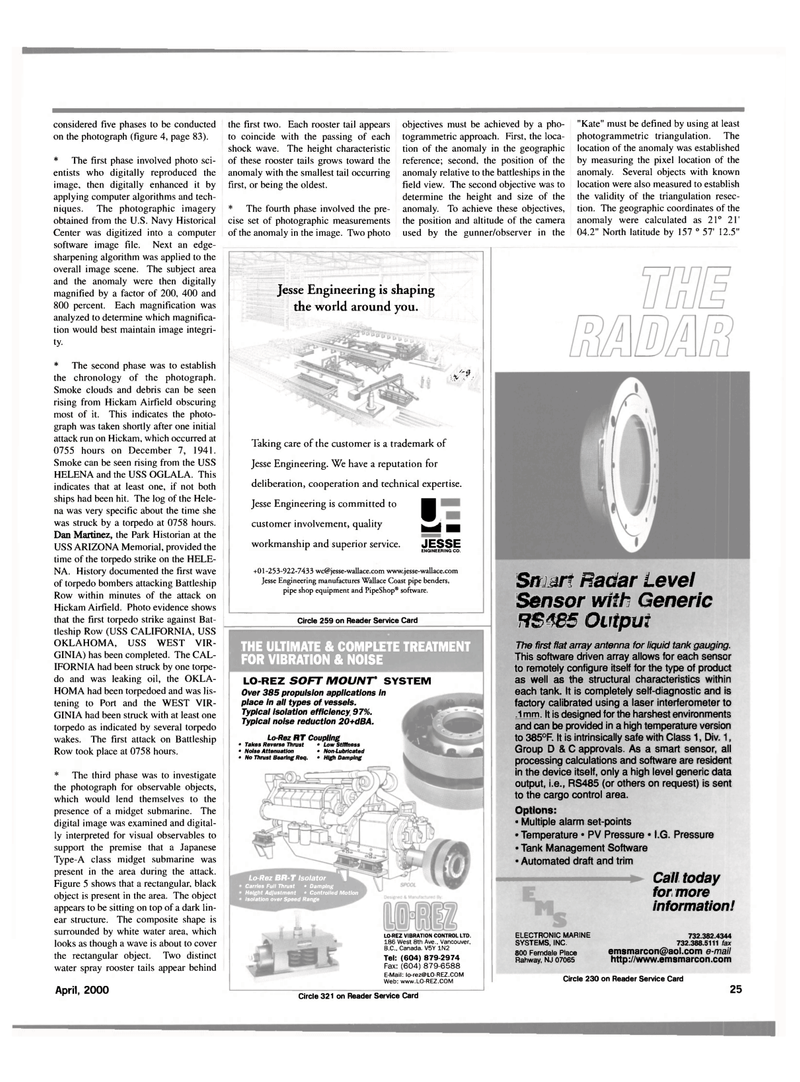
Page 25: of Maritime Reporter Magazine (April 2000)
Read this page in Pdf, Flash or Html5 edition of April 2000 Maritime Reporter Magazine
considered five phases to be conducted on the photograph (figure 4, page 83). * The first phase involved photo sci- entists who digitally reproduced the image, then digitally enhanced it by applying computer algorithms and tech- niques. The photographic imagery obtained from the U.S. Navy Historical
Center was digitized into a computer software image file. Next an edge- sharpening algorithm was applied to the overall image scene. The subject area and the anomaly were then digitally magnified by a factor of 200, 400 and 800 percent. Each magnification was analyzed to determine which magnifica- tion would best maintain image integri- ty. * The second phase was to establish the chronology of the photograph.
Smoke clouds and debris can be seen rising from Hickam Airfield obscuring most of it. This indicates the photo- graph was taken shortly after one initial attack run on Hickam, which occurred at 0755 hours on December 7, 1941.
Smoke can be seen rising from the USS
HELENA and the USS OGLALA. This indicates that at least one, if not both ships had been hit. The log of the Hele- na was very specific about the time she was struck by a torpedo at 0758 hours.
Dan Martinez, the Park Historian at the
USS ARIZONA Memorial, provided the time of the torpedo strike on the HELE-
NA. History documented the first wave of torpedo bombers attacking Battleship
Row within minutes of the attack on
Hickam Airfield. Photo evidence shows that the first torpedo strike against Bat- tleship Row (USS CALIFORNIA, USS
OKLAHOMA, USS WEST VIR-
GINIA) has been completed. The CAL-
IFORNIA had been struck by one torpe- do and was leaking oil, the OKLA-
HOMA had been torpedoed and was lis- tening to Port and the WEST VIR-
GINIA had been struck with at least one torpedo as indicated by several torpedo wakes. The first attack on Battleship
Row took place at 0758 hours. * The third phase was to investigate the photograph for observable objects, which would lend themselves to the presence of a midget submarine. The digital image was examined and digital- ly interpreted for visual observables to support the premise that a Japanese
Type-A class midget submarine was present in the area during the attack.
Figure 5 shows that a rectangular, black object is present in the area. The object appears to be sitting on top of a dark lin- ear structure. The composite shape is surrounded by white water area, which looks as though a wave is about to cover the rectangular object. Two distinct water spray rooster tails appear behind
April, 2000 the first two. Each rooster tail appears to coincide with the passing of each shock wave. The height characteristic of these rooster tails grows toward the anomaly with the smallest tail occurring first, or being the oldest. * The fourth phase involved the pre- cise set of photographic measurements of the anomaly in the image. Two photo objectives must be achieved by a pho- togrammetric approach. First, the loca- tion of the anomaly in the geographic reference; second, the position of the anomaly relative to the battleships in the field view. The second objective was to determine the height and size of the anomaly. To achieve these objectives, the position and altitude of the camera used by the gunner/observer in the "Kate" must be defined by using at least photogrammetric triangulation. The location of the anomaly was established by measuring the pixel location of the anomaly. Several objects with known location were also measured to establish the validity of the triangulation resec- tion. The geographic coordinates of the anomaly were calculated as 21° 21' 04.2" North latitude by 157 ° 57' 12.5"
Jesse Engineering is shaping the world around you. m,
Taking care of the customer is a trademark of
Jesse Engineering. We have a reputation for deliberation, cooperation and technical expertise.
Jesse Engineering is committed to ^p customer involvement, quality __ workmanship and superior service. JESSE 1 ENGINEERING CO. +01-253-922-7433 [email protected] www.jesse-wallace.com
Jesse Engineering manufactures Wallace Coast pipe benders, pipe shop equipment and PipeShop® software.
Circle 259 on Reader Service Card
THE ULTIMATE & COMPLETE TREATMENT
FOR VIBRATION & NOISE
LO-REZ SOFT MOUNT" SYSTEM
Over 385 propulsion applications in place in all types of vessels.
Typical isolation efficiency 97%.
Typical noise reduction 20+dBA.
Lo-Rez RT Coupling • Takes Reverse Thrust • Low Stiffness • Noise Attenuation • Non-Lubricated • No Thrust Bearing Req. • High Damping m Lo-Rez BR-T Isolator m
Carries Full Thrust • Damping
Height Adjustment • Controlled Motion
Isolation over Speed Range
LO-REZ VIBRATION CONTROL LTD. 186 West 8th Ave.. Vancouver,
B.C., Canada. V5Y 1N2
Tel: (604) 879-2974
Fax: (604) 879-6588
E-Mail: lo-rez@L0 REZ.COM
Web: www.LO-REZ.COM
Smart Radar Level
Sensor with Generic
HB4B5 Oiitput
The first flat array antenna for liquid tank gauging.
This software driven array allows for each sensor to remotely configure itself for the type of product as well as the structural characteristics within each tank. It is completely self-diagnostic and is factory calibrated using a laser interferometer to •1mm. It is designed for the harshest environments and can be provided in a high temperature version to 385°F. It is intrinsically safe with Class 1, Div. 1,
Group D & C approvals. As a smart sensor, all processing calculations and software are resident in the device itself, only a high level generic data output, i.e., RS485 (or others on request) is sent to the cargo control area.
Options: «Multiple alarm set-points • Temperature • PV Pressure • i.G. Pressure • Tank Management Software • Automated draft and trim
Call today for more information!
ELECTRONIC MARINE
SYSTEMS, INC. 800 Ferndale Place
Rahway, NJ 07065 732.382.4344 732.388.5111 fax [email protected] e-mail http://www.emsmarcon.com
Circle 230 on Reader Service Card
Circle 321 on Reader Service Card 25

 24
24

 26
26
